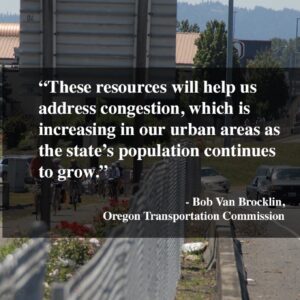
(Photo: Jonathan Maus/BikePortland)
New guidance from the U.S. Department of Transportation has sent a clear signal to states: Spend more “highway safety” money on projects that protect people who are not driving.
The Biden infrastructure plan infused the Federal Highway Administration’s Highway Safety Improvement Program (HSIP) with extra funding – it will have a budget of about $4 billion more in the next four years than it did from 2016-2020.
According to the FHWA press release, the guidance “ensures that the new funds are used strategically to make travel safer, including protecting people outside of vehicles, such as people walking, biking, or using mobility assistive devices, thereby reducing the number of lives lost on the nation’s highways, bridges, and roads.”
The Vulnerable Road User Safety Special Rule is a notable part of these new guidelines. This rule requires states to dedicate at least 15% of its HSIP funds to projects that address the safety of those road users if these vulnerable road users make up 15 percent or more of the total number of traffic fatalities in a state in a given year.
Given the sad state of traffic fatalities in Portland that are mirrored in a 2021 statewide death toll that was the highest in 30 years, we wondered how — or if — the new federal guidance will impact Oregon.
Advertisement
According to Oregon Department of Transportation Assistant Communications Director Katherine Benenati, the state doesn’t know exactly what it will be required to do as a result of the new rule.
ODOT reports that people who died in traffic crashes while walking or riding a bike have consistently made up around 20% of Oregon’s total traffic fatalities since 2015. 40% of these took place in the Portland metro area. So, it looks like the federal funding threshold will have been met.
However, the state may already be meeting this funding requirement through existing programs.
Right now, federal safety funds in Oregon are distributed through the All Roads Transportation Safety (ARTS) Program, which the IIJA act gives Oregon another $40 million for.
Benenati says that at least 7.5% of ARTS funding goes to safety improvements for people who walk and bike, but the agency actually funds more than that.
“More than a quarter of all applications being scoped in this round of ARTS include countermeasures that improve pedestrian and bicycle safety statewide, so we are confident that we will meet the 15% bike/ped project obligation for the next STIP cycle as we typically identify that much bike/ped spending through our normal process,” Benenati says.
ODOT has other programs dedicated to funding safety improvements for people who walk or bike, and the transportation department’s Transportation Safety Action Plan (TSAP), which was updated last October, acknowledges the efforts needed to protect vulnerable road users.
But many local, state and federal efforts to prevent traffic fatalities, especially among vulnerable people, haven’t demonstrated success as these incidents continue to rise. However, with more funding programs like this for safety improvements for people who bike and walk, as well as the attention U.S. Transportation Secretary Pete Buttigieg has given to the problem, we hope that America is on a better path to preventing the needless deaths we’re currently seeing all over the country.









Thanks for reading.
BikePortland has served this community with independent community journalism since 2005. We rely on subscriptions from readers like you to survive. Your financial support is vital in keeping this valuable resource alive and well.
Please subscribe today to strengthen and expand our work.
Having lived in Oregon for far too long and know way too many people that work for PDOT. . .
Would our illustrious PDOT/ODOT use this pot of money for the non-car projects they already have in their pipelines and not come up with anything new? Then re-route the money that had been allocated for those prior projects and divert them to the car-centric projects they prefer?
Doubt anyone has an answer, but makes me wonder . . .
A lot of those projects take years to plan, and line up finances. It seems like anything that gets built in the next 4 years will already have the $ lined up, right? Does this added money apply to new projects conceived and planned in the next 4 years? I’m not sure how that is managed.
Either way, I’m hopeful we get “extra” new projects that are actually useful, and not ODOT building sidewalks in the middle of nowhere as part of a new highway project.
Wonder what percentage of that money is being spent on replacing plastic wands…
My guess is there may be some small improvements but they will have little impact, if any, on the number of deaths. Stuff happens. They aren’t going to build bike paths everywhere people want to bike so bikes will still be riding next to cars. Accidents will happen. Realistically there isn’t much you can do about it except take responsibility for yourself. Dress in highly visible colors and use 2 flashing lights front and rear, and be careful. If you get hit and the car driver says “I didn’t see him/her”, then the police can ask “Are you blind?”
I recommend fluorescent orange or yellow tops. Car drivers are distracted, that will never change, so do your best to be easily visible to them.
The United States has 12.4 road deaths per 100,000 people. Norway has 2 per 100,000. France has 5 per 100,000. Canada has 5.8 per 100,000.
https://en.wikipedia.org/wiki/List_of_countries_by_traffic-related_death_rate
Maybe instead of saying ‘accidents will happen’, we should be saying ‘why are Americans dying at over twice the rate of Canadians on the road?’
When cyclists are hit, police almost always take the side of the motorist. Police are motorists first and engage in dangerous driving behavior both on and off the clock just as much as your average driver. Every one should have cameras on their bikes so they don’t have to rely on the police, who are unlikely to actually think critically about the incident.
Interesting stats, but they have no meaning without comparing the differences in the countries.
My comment was about accidents where cyclists are hit by motor vehicles, i.e.”cars”. Your statistics are about “road deaths per capita”, which has little if anything to do with cars hitting cyclists since fewer than 1,000 cyclists die per year from being hit by a car in the USA.
https://injuryfacts.nsc.org/home-and-community/safety-topics/bicycle-deaths/
Also, more deaths per capita on the road tells us more about who is driving the most miles rather than who has the safer roads. Your numbers make the US look horrible, but we drive more than twice the miles per year as France and Norway, and 1.65 times as many as Canada.
https://internationalcomparisons.org/environmental/transportation/
Per your list, the number of deaths per 1 billion vehicle kilometers is:
USA 7.3
Norway 3.0
France 5.8
Canada 5.1
Thus, we are only 1.43 times the deaths as Canada, not twice. To find out why, a worthy goal, you’d need to look at many factors.
A driver rear-ended me on my bike while I was doing all the things you said I need to do to “take responsibility.”
Here is info on it. This should be posted as an article on BP – it could save lives:
https://www.roadbikerider.com/incisive-new-studies-on-cyclist-visibility-d3/
https://www.bicycling.com/bikes-gear/g20017365/the-science-of-being-seen-a-guide-to-safer-riding/